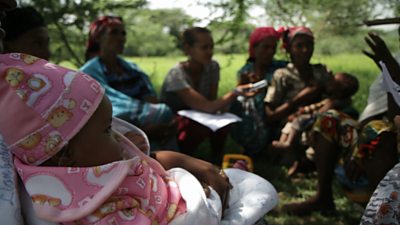Downloads
The project
Since 2013 ���˿��� Media Action has produced two radio magazine programmes in Ethiopia – Biiftuu Jireenyaa (Dawn of Life) and Jember (Maternal Light) – targeting women of reproductive age (15 to 45) and their husbands. Both aim to increase knowledge around maternal and child health practices and to facilitate a decision-making process that supports healthier behaviours. The shows include segments (e.g. ‘Husbands’ Corner’) that specifically seek to encourage men to engage with these issues.
Made on location, the programmes comprise real stories from listeners – including health workers’ and rural people’s voices – as well as music, proverbs and poetry. They are aired on three regional broadcasters: Oromia Radio and Television Organisation, Ethiopian Broadcasting Corporation and Amhara Radio Network.
In 2016 ���˿��� Media Action carried out a survey representative of those aged 15 and above in the three regions in which the project operates (Amhara, Oromia and the Southern Nations, Nationalities, and People’s Region). This found that the programmes reached 13.8 million people and that listening was associated with higher levels of maternal and child health knowledge and uptake of healthier practices.
Research approach
To complement the earlier quantitative work, in 2016 ���˿��� Media Action conducted a qualitative study to explore how its radio programmes might have impacted people’s views on four social norms:
- Husbands should not be involved in pregnancy as it is a ‘woman’s matter’
- Preparing for birth might bring bad luck
- Delivery in a health facility is only needed if there are complications with the birth
- Colostrum (first yellow milk) can harm the baby
A social norm is herein understood as:
“…a rule of collective such that individuals prefer to conform to it on condition that they believe that a) most people in their reference network conform to it, and b) that most people in their reference network believe that they ought to conform to it”.
���˿��� Media Action researchers carried out 18 interviews in total. They first asked seven new mothers (from Amhara and Oromia regions) who were listeners of ���˿��� Media Action’s radio programme(s) about their recent pregnancies and experiences of childbirth. Using a personal narrative approach, researchers encouraged the women to narrate their journey before and after pregnancy and to identify the key people who influenced it (‘reference group members’). They then conducted supporting interviews with these individuals, generally women’s husbands, mothers, mothers-in-law and Health Extension Workers (HEWs).
Key findings
1. Participants reported performing many of the pregnancy and childbirth-related behaviours targeted. For example, both new mothers and fathers reported that husbands were highly involved in their wives’ pregnancies, encouraging them to attend antenatal care, eat well and rest.
2. Interviewees felt social norms were changing. Participants noted changes when comparing their earlier experiences of childbirth to later ones and when considering society at large. For example, mothers thought that: husbands in their communities were now more involved in pregnancy and childbirth, birth preparedness was increasing, and all babies were now being fed colostrum.
3. Participants attributed these changes to HEWs and the media. In some cases they specifically mentioned ���˿��� Media Action’s two shows, Biiftuu Jireenyaa and Jember as leading to changes in social norms.
4. ���˿��� Media Action’s programmes appear to have contributed to an environment that supports decision-making on healthier practices.
- The shows encouraged discussion between women and reference group members. Even when they hadn’t, they had influenced the latters’ opinions
- By providing the same advice as that given by HEWS, the programmes were also found to have complemented HEWs’ work and reinforced their credibility
- Interviewees thought delivery in health facilities were now typical because people receive such guidance from HEWs and the media. This is despite Ethiopia’s 2016 Demographic and Health Survey showing that only 26% of births in the preceding five years had taken place in a health facility. This therefore suggests that the shows – through testimonials, expert advice, and role-modelling best practice – had contributed to giving the impression that going to a health facility was common practice.
5. Some barriers to healthier behaviours remain. Some of the experiences women described – such as an unwelcome pregnancy or a previous negative experience in a health facility – acted as barriers to them practising healthier behaviours. These were beyond the control of ���˿��� Media Action’s two radio programmes.
Implications
The findings from this research suggest several pathways through which media outputs – such as ���˿��� Media Action’s two radio magazine programmes – can contribute to maternal and child health social norm change in Ethiopia:
1. Fostering discussion
2. Facilitating consensus (even in the absence of discussion)
3. Complementing the work of HEWs
Through role-modelling, positive testimonials and expert advice, ���˿��� Media Action’s two radio shows may also be giving the impression of social norm shifts, thereby contributing to such changes.
